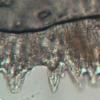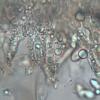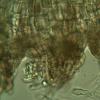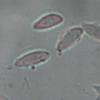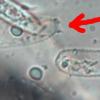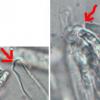
02-12-2025 18:59
This pair of ascos 2.5cm across were on recently b

02-12-2025 19:25
Buckwheat PeteHello, can anyone identify this hairy fungus growi

30-11-2025 12:53
 Edvin Johannesen
Edvin Johannesen
White short-stipitate apothecia found on thin twig

30-11-2025 10:47
 William Slosse
William Slosse
I recently found a collection of small Peziza sp.

27-11-2025 12:01
Thomas Læssøehttps://svampe.databasen.org/observations/10496727

27-11-2025 11:46
Thomas Læssøehttps://svampe.databasen.org/observations/10493918

Hello,
today Tanja found a small white stipitate Hyaloscyphaceae (?) with hairy disc. We thought it to be a Lachnum species, although the stipe was unusually thin and naked.
The micrscopy revealed, that it is far from being a Lachnum.
I'm not even sure, wether it really is a Hyaloscyphaceae, or may even be a Sclerotiniaceae?
The hairs are quite short, approx. 40-50 µm long, and 1-2-3-celled. They stick together to form a dentate margin, but some are solitary or straight and not agglomerated teeth-like. They are filled with yellwo-brownish refringent guttules.
The paraphyses are cylindrical, approx. 2-3 µm broad, and filled in the upper part with refringent guttules.
The asci are without croziers, 8-spored, and with a minute pore that reacts blue in Barals. But it is so tiny and incospicou, you have to open the diaphragma completely to be certain about the IKI bb reaction.
What is very remarkable is the wall thickening of the dead, open asci. I tried to fotograph that, it is indicated by the red arows. This looks more like the ascus apex in Sclerotiniaceae!
The spores are fusoid to rhomboid, 9-10 x 3,5-3,8 µm, without oil or rarely with very little oil in one end (oil 0-0,5).
Growing on a small root (diam. approx.1-2 mm) of Quercus, semiimmersed in soil, approx. 30 apothecia on 5 cm long root.
Any ideas someone? May be a Ciborinia?
thank you and best regards,
Andreas


Hello Zotto,
thank you for that idea. I was thinking of a Cyathicula, but the excipulum is no textura oblita but a textura prismatica.
I will verify the croziers, I still have fresh material.
I don't have that Cyathicula microspora in my folders, but I have only the 2005 DVD version. I have not yet succeeded in finding your up-to-date keys and/or pictures.
best regards,
Andreas

https://www.cubbyusercontent.com/pl/CC%2bAscomycota/_1354d48ffaad4b59bd3ffdbb35915d1f#CC%20Ascomycota/7a%20Helotiales/5a%20Helotiaceae

Hallo Zotto,
besten Dank für Deinen Link. Nach Ewigkeiten hat sich die Seite dann auch geöffnet. leider kann ich aber die Bilder nicht vergrößern, und in der seitenpassenden Ansicht kann ich nichts lesen. Außerdem hat es die meisten Bilder im Ordner nicht geladen. keine Ahnung warum, denn wir haben superschnelles Internet.
Ich habe mir jetzt die Zeichnung 8202-7 auf den Desktop kopiert und von dort aus kann ich sie vergrößern und scrollen.
Es passt alles perfekt, auch die Farbe "zuerst rein weiß, alt werdend bräunlich-gelb". Einzig waren bei mir die Guttulen in den paraphysen eher kurzzylindrisch als so schön rund wie auf deiner Zeichnung. Aber auch die beschreibung des Mini-Poruses und der teilweise zusammenneigenden Haare - alles genau dasselbe. Ach ja - die Sporen waren bei mir dann doch ein bissel größer, bis 9-10 x 3,5-3,8 µm. Vielleicht sogar noch ein wenig größer, wenn ich noch mehr messen würde.
Eine gültige Kombination gibt es dafür noch nicht, oder? Denn bei Cyathicula kann man das Teil ja schwerlich belassen ...
beste Grüße,
Andreas

Genetisch steht das Teil wirklich nicht bei Cyathicula, sondern sehr schön bei Hymenoscyphus monotropae, was aber auch kein Hymenoscyphus ist. Calyptellopsis wäre ein heißes Eisen dafür, aber wurde bislang nicht sequenziert.
